The Influence of Minor Additions of La and Ce on the Microstructural Components and Forming Properties of Al-1.4Fe Alloys
Abstract
:1. Introduction
2. Materials and Methods
3. Results and Discussion
3.1. Homogenization Simulation
3.2. Microstructure Analysis
3.3. Forming Propetries
4. Conclusions
Author Contributions
Funding
Institutional Review Board Statement
Informed Consent Statement
Data Availability Statement
Acknowledgments
Conflicts of Interest
References
- Shi, Z.M.; Gao, K.; Shi, Y.T.; Wang, Y. Microstructure and mechanical properties of rare-earth-modified Al–1Fe binary alloys. Mater. Sci. Eng. 2015, 632, 62–71. [Google Scholar] [CrossRef]
- Kral, M.V.; McIntyre, H.R.; Smillie, M.J. Identification of intermetallic phases in a eutectic Al-Si casting alloy using electron backscatter diffraction pattern analysis. Scr. Mater. 2004, 51, 215–219. [Google Scholar] [CrossRef]
- Kral, M.V.; Nakashima, P.N.H.; Mitchell, D.R.G. Electron microscope studies of Al–Fe–Si intermetallics in an Al-11 Pct Si alloy. Met. Mater. Trans. A 2006, 37, 1987–1997. [Google Scholar] [CrossRef]
- Birol, Y. Thermomechanical processing of a twin-roll cast Al–Fe1–0.2Si alloy. J. Mater. Process. Technol. 2008, 202, 564–568. [Google Scholar] [CrossRef]
- Sheppard, T. Extrusion of Aluminium Alloys; Springer: Berlin/Heidelberg, Germany, 1999. [Google Scholar]
- ASM International. ASM Handbook, 4E: Heat Treating of Nonferrous Alloys; Materials Park: Cleveland, OH, USA, 2016. [Google Scholar]
- Rinderer, B. Heat Treating of Nonferrous Alloys. Mater. Sci. Forum 2011, 693, 264–275. [Google Scholar] [CrossRef]
- Sundman, B. An assessment of the entire Al–Fe system including D03 ordering. Acta Mater. 2009, 57, 2896–2908. [Google Scholar] [CrossRef]
- Allen, C.M.; O’Reilly, K.A.Q.; Cantor, B.; Evans, P.V. A calorimetric evaluation of the role of impurities in the nucleation of secondary phases in 1xxx Al alloys. Mat. Res. Soc. Symp. Proc. 1997, 481, 3–14. [Google Scholar] [CrossRef]
- Chen, J.; Dahlborg, U.; Bao, C.M.; Calvo-Dahlborg, M.; Henein, H. Microstructure Evolution of Atomized Al-0.61 wt pct Fe and Al-1.90 wt pct Fe Alloys. Met. Mater. Trans. B 2011, 42, 557–567. [Google Scholar] [CrossRef]
- Skjerpe, P. Intermetallic phases formed during DC-casting of an Al-0.25 Wt Pct Fe-0.13 Wt Pct Si alloy. Met. Trans. A 1987, 18, 189–200. [Google Scholar] [CrossRef]
- Li, Y.J.; Arnberg, L. A eutectoid phase transformation for the primary intermetallic particle from Alm(Fe,Mn) to Al3(Fe,Mn) in AA5182 alloy. Acta Mater. 2004, 52, 2945–2952. [Google Scholar] [CrossRef]
- Young, R.M.K.; Clyne, T.W. An AlFe intermetallic phase formed during controlled solidification. Scr. Metall. 1981, 15, 1211–1216. [Google Scholar] [CrossRef]
- Allen, C.M.; O’Reilly, K.A.Q.; Cantor, B.; Evans, P.V. Intermetallic phase selection in 1XXX Al Alloys. Prog. Mater. Sci. 1998, 43, 89–170. [Google Scholar] [CrossRef]
- Lin, G.; Li, L.; Guo, Z.; Jia, X.; Wang, X.; Yuan, Z.; Zhang, G.; Zhan, Y.; Shan, Q.; Li, Z. Influence of cerium and yttrium addition on strength and electrical conductivity of pure aluminum alloys. J. Rare Earths 2024, 42, 600–611. [Google Scholar] [CrossRef]
- Zhang, Y.; Wei, F.; Mao, J.; Niu, G. The difference of La and Ce as additives of electrical conductivity aluminum alloys. Mater. Charact. 2019, 158, 109963. [Google Scholar] [CrossRef]
- He, Y.; Liu, J.; Qiu, S.; Deng, Z.; Zhang, J.; Shen, Y. Microstructure evolution and mechanical properties of Al-La alloys with varying La contents. Mater. Sci. Eng. 2017, 701, 134–142. [Google Scholar] [CrossRef]
- Jiang, W.; Fan, Z.; Dai, Y.; Li, C. Effects of rare earth elements addition on microstructures, tensile properties and fractography of A357 alloy. Mater. Sci. Eng. A 2014, 597, 237–244. [Google Scholar] [CrossRef]
- Alkahtani, S.A.; Elgallad, E.M.; Tash, M.M.; Samuel, A.M.; Samuel, F.H. Effect of rare earth metals on the microstructure of Al-Si based alloys. Materials 2016, 9, 45. [Google Scholar] [CrossRef]
- Moldovan, P.; Popescu, G.; Miculescu, F. Microscopic study regarding the microstructure evolution of the 8006 alloy in the plastic deformation process. J. Mater. Process. Technol. 2004, 153, 408–415. [Google Scholar] [CrossRef]
- Lou, G.; Zhou, X.; Li, C.; Du, J.; Huang, Z. Design and preparation of Al-Fe-Ce ternary aluminum alloys with high thermal conductivity. Trans. Nonferrous Met. Soc. China 2022, 32, 1781–1794. [Google Scholar]
- Wang, W.; Pan, Q.; Lin, G.; Yu, Y.; Wang, X.; Liu, Y.; Sun, Y.; Ye, J.; Huand, Z.; Xiang, S.; et al. Internal friction and heat resistance of Al, Al–Ce, Al–Ce–Zr and Al–Ce–(Sc)–(Y) aluminum alloys with high strength and high electrical conductivity. J. Mater. Res. Technol. 2021, 14, 1255–1274. [Google Scholar] [CrossRef]
- Zhang, S.B.; Su, Y.; Gong, W.G. Effects of rare earth elements on microstructure and tensile properties of Al-Si-Cu alloy at 250 °C. China Foundry 2021, 18, 474–480. [Google Scholar] [CrossRef]
- Ibrahim, M.F.; Abdelaziz, M.H.; Samuel, A.M.; Doty, H.W.; Samuel, F.H. Effect of rare earth metals on the mechanical properties and fractography of Al–Si-based alloys. Inter. Metalcast. 2019, 14, 108–124. [Google Scholar] [CrossRef]
- Vončina, M.; Medved, J.; Steinacher, M.; Ozimič, K. The influence of La and Ce additions on the solidification of alloys from the Al–Fe system. J. Therm. Anal. Calorim. 2024. [Google Scholar] [CrossRef]
- Meng, C.; Tang, H.; Wang, C.; Sun, Y.; Peng, F.; Zheng, X.; Wang, J. Anti-fading study of Al–Ti–B by adding Ce on 6111 aluminum alloy. J. Mater. Res. Technol. 2024, 30, 2420–2434. [Google Scholar] [CrossRef]
- Xia, G.; Zhao, Q.; Ping, X.; Zhang, Y.; Yu, Q.; Li, Z.; Cai, Q. Effect of Al–5Ti–1B–La intermediate alloy on microstructure and mechanical properties of A356.2 aluminum alloy. J. Mater. Res. Technol. 2024, 30, 1458–1469. [Google Scholar] [CrossRef]
- Jiang, H.; Li, S.; Zhang, L.; He, J.; Zheng, Q.; Song, Y.; Li, Y.; Zhao, J. The influence of rare earth element lanthanum on the microstructures and properties of as-cast 8176 (Al-0.5Fe) aluminum alloy. J. Alloys Compd. 2021, 59, 157804. [Google Scholar] [CrossRef]
- Tsai, Y.C.; Chou, C.Y.; Lee, S.L.; Lin, C.K.; Lin, J.C.; Lim, S.W. Effect of trace La addition on the microstructures and mechanical properties of A356 (Al–7Si–0.35Mg) aluminum alloys. J. Alloys Compd. 2009, 487, 157–162. [Google Scholar] [CrossRef]
- Arbeiter, J.; Vončina, M.; Šetina Batič, B.; Medved, J. Transformation of the Metastable Al6Fe Intermetallic Phase during Homogenization of a Binary Al-Fe Alloy. Materials 2021, 14, 7208. [Google Scholar] [CrossRef]
- Arbeiter, J.; Vončina, M.; Volšak, D.; Medved, J. Evolution of Fe-based intermetallic phases during homogenization of Al–Fe hypoeutectic alloy. J. Therm. Anal. Calorim. 2020, 142, 1693–1699. [Google Scholar] [CrossRef]
- Liang, Y.H.; Shi, Z.M.; Li, G.W.; Zhang, R.Y.; Li, M. Effects of rare earth modification on microstructure refinement and mechanical properties of Al-2wt%Fe alloys. Mater. Res. Express 2019, 6, 106504. [Google Scholar] [CrossRef]
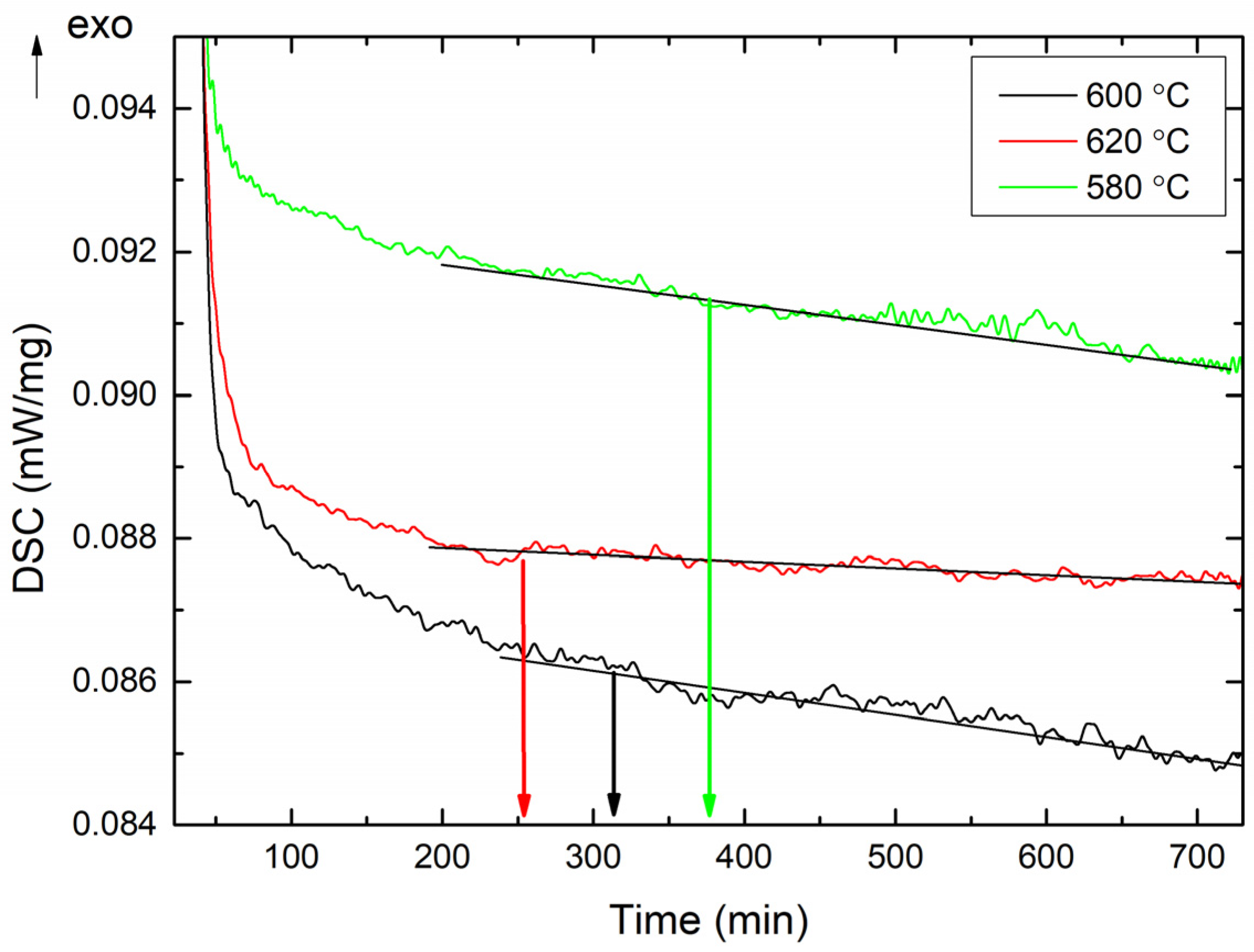
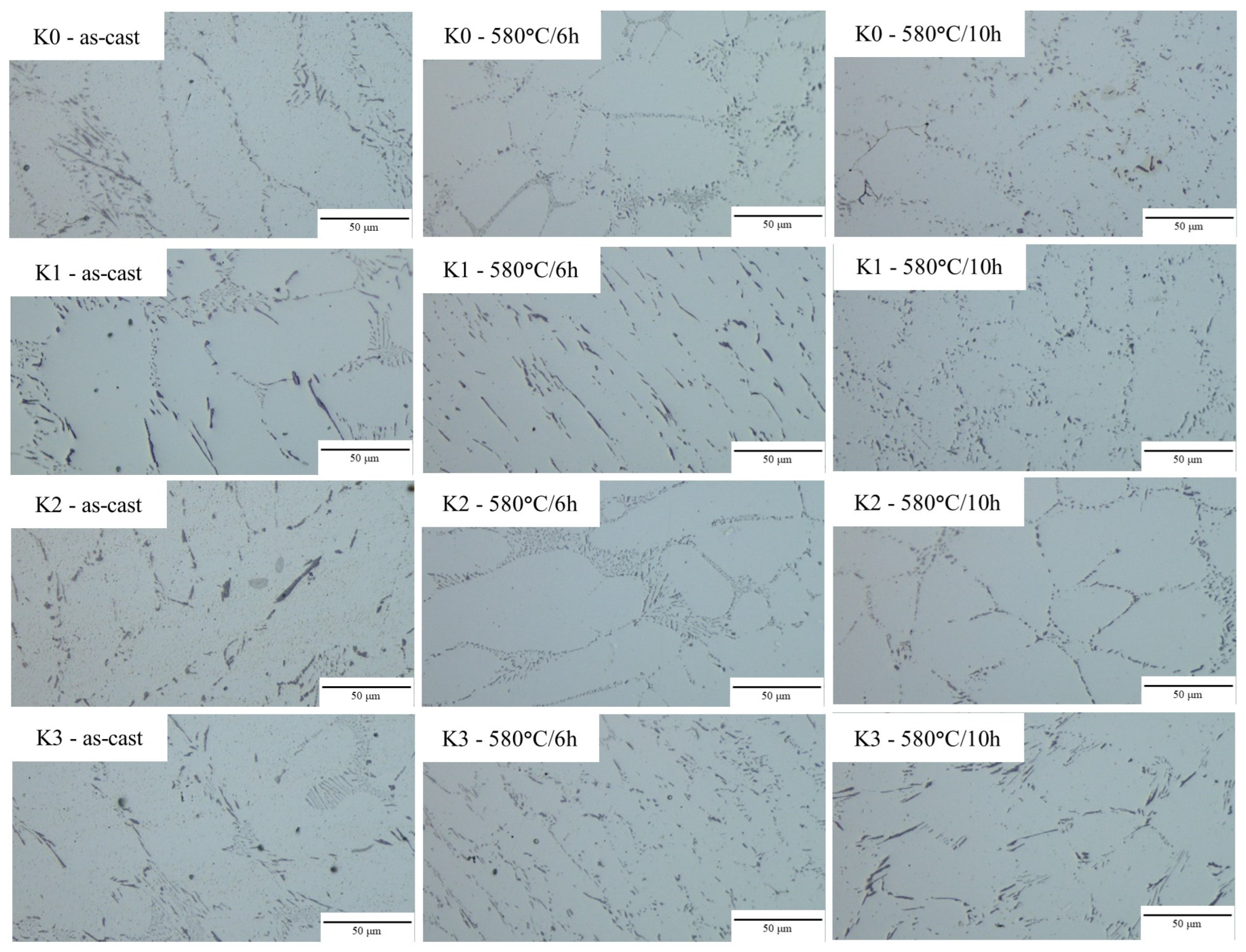

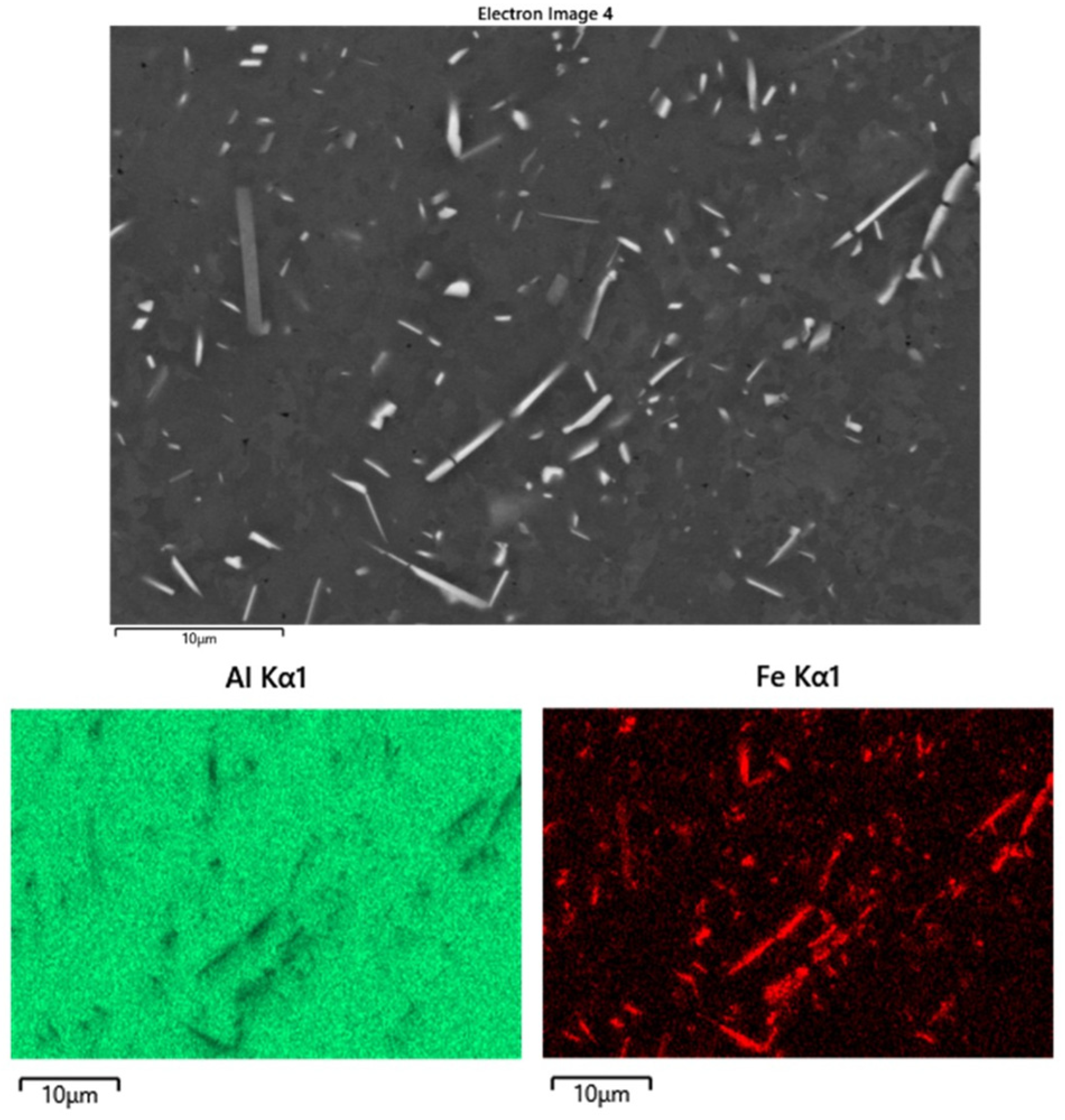


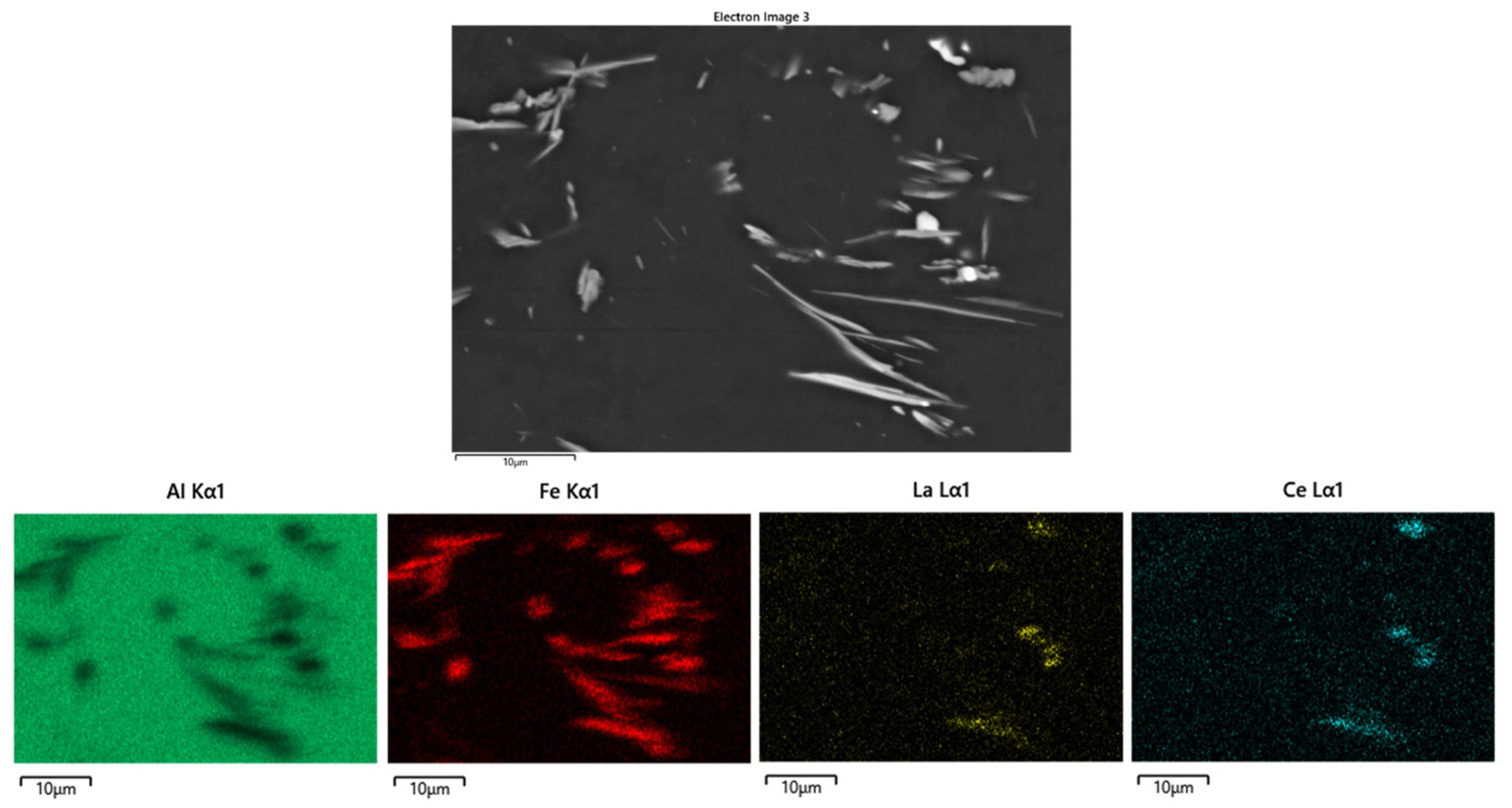
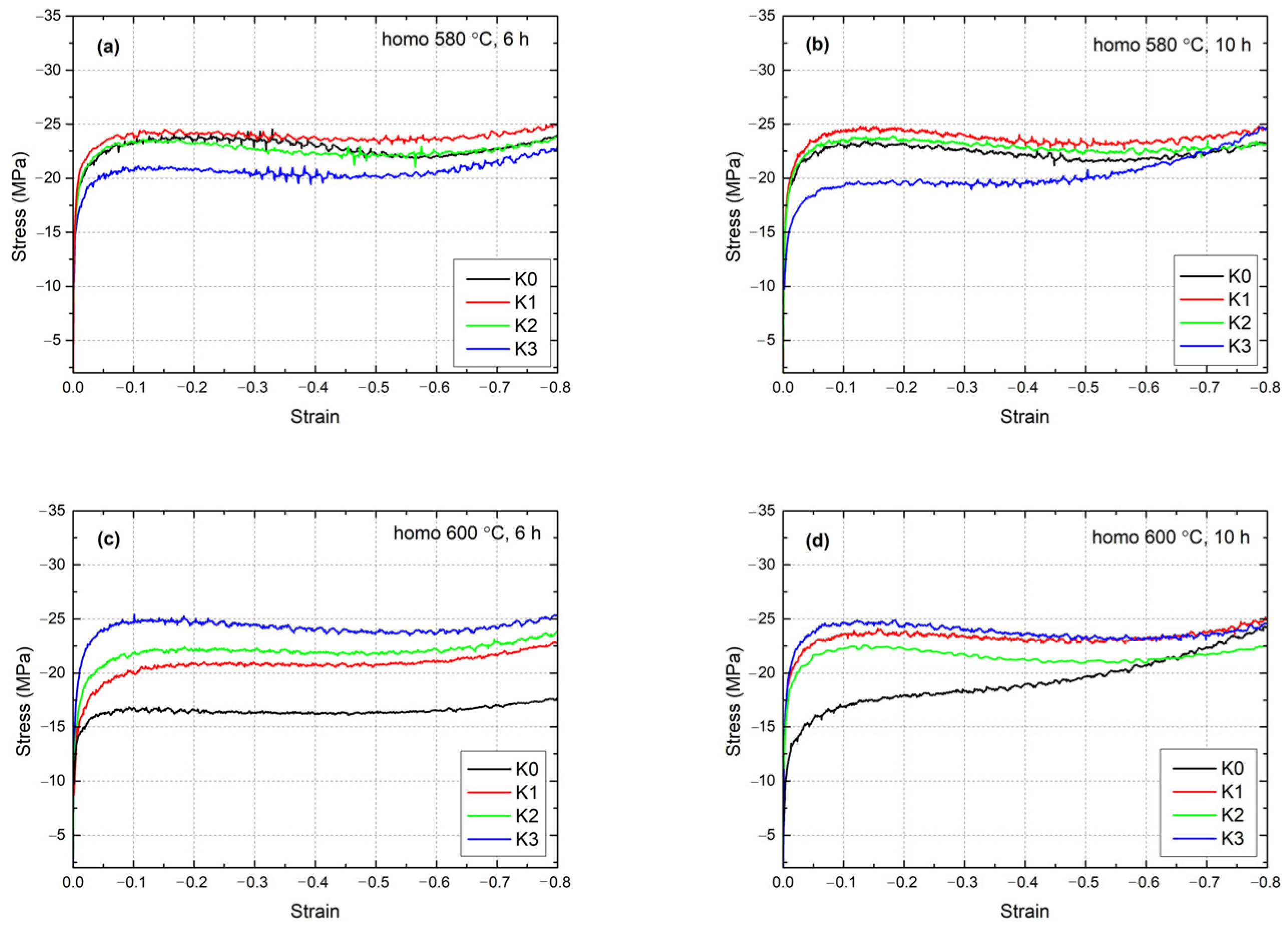
| Sample | Fe | Cu | Si | Mn | Mg | Ce | La | Al |
|---|---|---|---|---|---|---|---|---|
| K0 | 1.36 | 0.0009 | 0.0062 | 0.0013 | 0.0008 | <0.001 | <0.001 | Rest |
| K1 | 1.43 | 0.0012 | 0.0081 | 0.0023 | 0.0008 | <0.001 | 0.139 | Rest |
| K2 | 1.38 | 0.0011 | 0.0087 | 0.0058 | 0.0008 | 0.147 | <0.001 | Rest |
| K3 | 1.43 | 0.0012 | 0.0088 | 0.0075 | 0.0009 | 0.0708 | 0.0909 | Rest |
Disclaimer/Publisher’s Note: The statements, opinions and data contained in all publications are solely those of the individual author(s) and contributor(s) and not of MDPI and/or the editor(s). MDPI and/or the editor(s) disclaim responsibility for any injury to people or property resulting from any ideas, methods, instructions or products referred to in the content. |
© 2024 by the authors. Licensee MDPI, Basel, Switzerland. This article is an open access article distributed under the terms and conditions of the Creative Commons Attribution (CC BY) license (https://creativecommons.org/licenses/by/4.0/).
Share and Cite
Vončina, M.; Medved, J.; Bombač, D.; Ozimič, K. The Influence of Minor Additions of La and Ce on the Microstructural Components and Forming Properties of Al-1.4Fe Alloys. Appl. Sci. 2024, 14, 8194. https://doi.org/10.3390/app14188194
Vončina M, Medved J, Bombač D, Ozimič K. The Influence of Minor Additions of La and Ce on the Microstructural Components and Forming Properties of Al-1.4Fe Alloys. Applied Sciences. 2024; 14(18):8194. https://doi.org/10.3390/app14188194
Chicago/Turabian StyleVončina, Maja, Jožef Medved, David Bombač, and Klavdija Ozimič. 2024. "The Influence of Minor Additions of La and Ce on the Microstructural Components and Forming Properties of Al-1.4Fe Alloys" Applied Sciences 14, no. 18: 8194. https://doi.org/10.3390/app14188194








